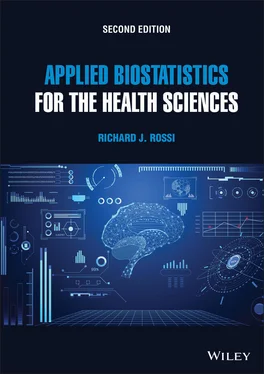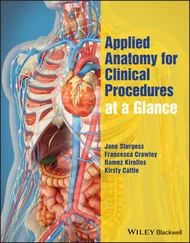Richard J. Rossi - Applied Biostatistics for the Health Sciences
Здесь есть возможность читать онлайн «Richard J. Rossi - Applied Biostatistics for the Health Sciences» — ознакомительный отрывок электронной книги совершенно бесплатно, а после прочтения отрывка купить полную версию. В некоторых случаях можно слушать аудио, скачать через торрент в формате fb2 и присутствует краткое содержание. Жанр: unrecognised, на английском языке. Описание произведения, (предисловие) а так же отзывы посетителей доступны на портале библиотеки ЛибКат.
- Название:Applied Biostatistics for the Health Sciences
- Автор:
- Жанр:
- Год:неизвестен
- ISBN:нет данных
- Рейтинг книги:3 / 5. Голосов: 1
-
Избранное:Добавить в избранное
- Отзывы:
-
Ваша оценка:
- 60
- 1
- 2
- 3
- 4
- 5
Applied Biostatistics for the Health Sciences: краткое содержание, описание и аннотация
Предлагаем к чтению аннотацию, описание, краткое содержание или предисловие (зависит от того, что написал сам автор книги «Applied Biostatistics for the Health Sciences»). Если вы не нашли необходимую информацию о книге — напишите в комментариях, мы постараемся отыскать её.
APPLIED BIOSTATISTICS FOR THE HEALTH SCIENCES Applied Biostatistics for the Health Sciences
Applied Biostatistics for the Health Sciences
Applied Biostatistics for the Health Sciences — читать онлайн ознакомительный отрывок
Ниже представлен текст книги, разбитый по страницам. Система сохранения места последней прочитанной страницы, позволяет с удобством читать онлайн бесплатно книгу «Applied Biostatistics for the Health Sciences», без необходимости каждый раз заново искать на чём Вы остановились. Поставьте закладку, и сможете в любой момент перейти на страницу, на которой закончили чтение.
Интервал:
Закладка:
A blinded study is a research study where the subjects in the study are not told which treatment they are receiving. A research study is a double-blind study when neither the subject nor the staff administering the treatment know which treatment a subject is receiving.
A clinical trial is a research study performed on humans and designed to evaluate a new treatment or drug or to investigate a specific health condition.
A randomized controlled study is a research study in which the subjects are randomly assigned to the treatments with one of the treatments being a control treatment; a control treatment may be a standard treatment, a placebo, or no treatment at all.
It is important to note that a research study may actually involve more than one of these protocols. For example, a longitudinal study is often a cohort study, a case–control study is a retrospective study, a longitudinal study is a prospective study, and a clinical trial may be run as a double-blind randomized controlled study. Also, the nature of a particular research study will dictate the research protocol that is used. Finally, of all of the study protocols, the randomized controlled study is the gold standard in biomedical research because it provides more control over the external factors that can bias the results of a study.
Most of the medical journals that publish biomedical research require the authors of an article to describe the research protocol that was used in their study. In fact, during the peer-review process a journal article undergoes prior to publication, the research protocol will be carefully scrutinized and research based on poor research protocols will not be published. Several examples of the different research protocols used in published biomedical research articles are given in Examples 1.3– 1.7.
Example 1.3
In the article “A prospective study of coffee consumption and the risk of symptomatic gallstone disease in men” published in the Journal of the American Medical Association (Leitzmann et al., 1999), the authors reported the results of a prospective cohort study designed to investigate whether coffee consumption helps prevent symptomatic gallstone disease. This study consisted of n = 46, 008 men, aged 40–75 years in 1986, without any history of gallstone disease, and the subjects were monitored for a 10-year period from 1986 to 1996.
Example 1.4
In the article “Hospitalization before and after gastric bypass surgery” published in the Journal of the American Medical Association (Zingmond et al., 2005), the authors reported the results of a retrospective research study designed to investigate the amount of time spent in a hospital 1–3 years after an individual receives a Roux-en-Y gastric bypass (RYGB). This study consisted of n=60,077 patients who underwent RYGB from 1995 to 2004 in California.
Example 1.5
In the article “Pesticides and risk of Parkinson disease: a population-based case–control study” published in the Archives of Neurology (Firestone et al., 2005), the authors reported the results of a case–control research study designed to investigate association between occupational and home-based pesticide exposure and idiopathic Parkinson disease. This study consisted of 250 subjects with Parkinson’s disease and 388 healthy control subjects.
Example 1.6
In the article “Randomized, double-blind, placebo-controlled trial of 2 dosages of sustained-release bupropion for adolescent smoking cessation” published in the Archives of Pediatric and Adolescent Medicine (Muramoto et al., 2007), the authors reported the results of a randomized controlled double-blind research study designed to investigate the efficacy of sustained release of bupropion hydrochloride for adolescent smoking cessation. This study consisted of n = 312 subjects recruited through media and community venues from March 1, 1999 to December 31, 2002, who were aged 14–17 years, smoked at least six cigarettes per day, had an exhaled carbon monoxide level of 10 ppm or greater, had at least two previous quit attempts, and had no other current major psychiatric diagnosis.
Example 1.7
In the article “Antidepressant efficacy of the antimuscarinic drug scopolamine: a randomized, placebo-controlled clinical trial” published in Archives of General Psychiatry (Furey et al., 2006), the authors reported the results of a double-blind, placebo-controlled, dose finding clinical trial designed to investigate the antidepressant efficacy of scopolamine. This study consisted of n = 19 currently depressed outpatients aged 18–50 years with recurrent major depressive disorder or bipolar disorder.
1.2.3 Observational Studies Versus Experiments
When two or more subpopulations or treatments are to be compared in a biomedical research study, one of the most important aspects of the research protocol is whether the researchers can assign the units to the subpopulations or treatment groups that are being compared. When the researchers control the assignment of the units to the different treatments that are being compared, the study is called an experiment , and when units come to the researchers already assigned to the subpopulations or treatment groups, the study is called an observational study . Thus, in an experiment the researcher has the ability to assign the units to the groups that are being compared, while in an observational study the units come to the researcher already assigned to the groups.
One of the main reasons an observational study is used instead of an experiment in a biomedical research study is that it would be unethical to assign some subjects to a treatment that is known to be harmful and the remaining subjects to a treatment that is not harmful. For example, in a prospective 30-year study of the effects of smoking cigarettes, it would be unethical to assign some subjects to be smokers and others to be non-smokers.
For ethical reasons, observational studies are often used in epidemiological studies designed to investigate the risk factors associated with a disease. Also, a retrospective study is always an observational study because it looks backward in time and the units have already been assigned to the groups being compared. On the other hand, a prospective study and a clinical trial can be run as either experiments or observational studies depending on whether it is possible for the researcher to assign the units to the groups.
Example 1.8
Determine whether it would be possible to perform an experiment in each of the scenarios given below.
1 a. A nutritionist is interested in comparing several different diets in a prospective study. The treatments that will be compared are 10% fat in the diet, 15% fat in the diet, and 25% fat in the diet.
2 b. A pediatrician is interested in studying the effects of a mother’s use of tobacco on the birth weight of her baby. The two treatments that are to be compared are smoking during pregnancy and not smoking during pregnancy.
3 c. A medical researcher is studying the efficacy of vitamin C as a preventive measure against the common cold. The two treatments that are being compared are 1000 mg vitamin C and 1000 mg placebo.
Solutions
1 a. Because the researcher can assign the subjects to each of the three diets in this study, it could be performed as an experiment.
2 b. Because smoking is known to have harmful effects on a fetus, it would be unethical for a pediatrician to assign some mothers smoke during pregnancy and others to not smoke during pregnancy. This study would have to be performed as an observational study by comparing the weights of babies born to mothers who chose to smoke during pregnancy with babies born to mothers who did not smoke during pregnancy.
Читать дальшеИнтервал:
Закладка:
Похожие книги на «Applied Biostatistics for the Health Sciences»
Представляем Вашему вниманию похожие книги на «Applied Biostatistics for the Health Sciences» списком для выбора. Мы отобрали схожую по названию и смыслу литературу в надежде предоставить читателям больше вариантов отыскать новые, интересные, ещё непрочитанные произведения.
Обсуждение, отзывы о книге «Applied Biostatistics for the Health Sciences» и просто собственные мнения читателей. Оставьте ваши комментарии, напишите, что Вы думаете о произведении, его смысле или главных героях. Укажите что конкретно понравилось, а что нет, и почему Вы так считаете.












